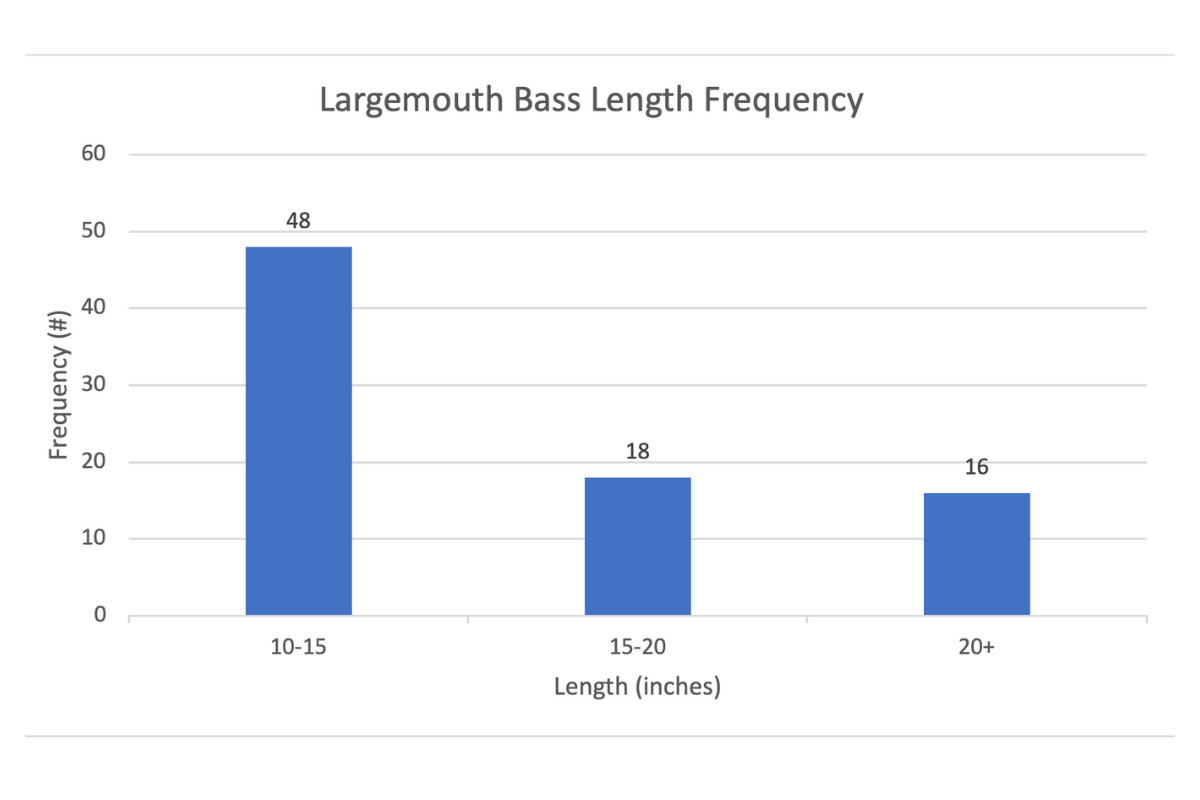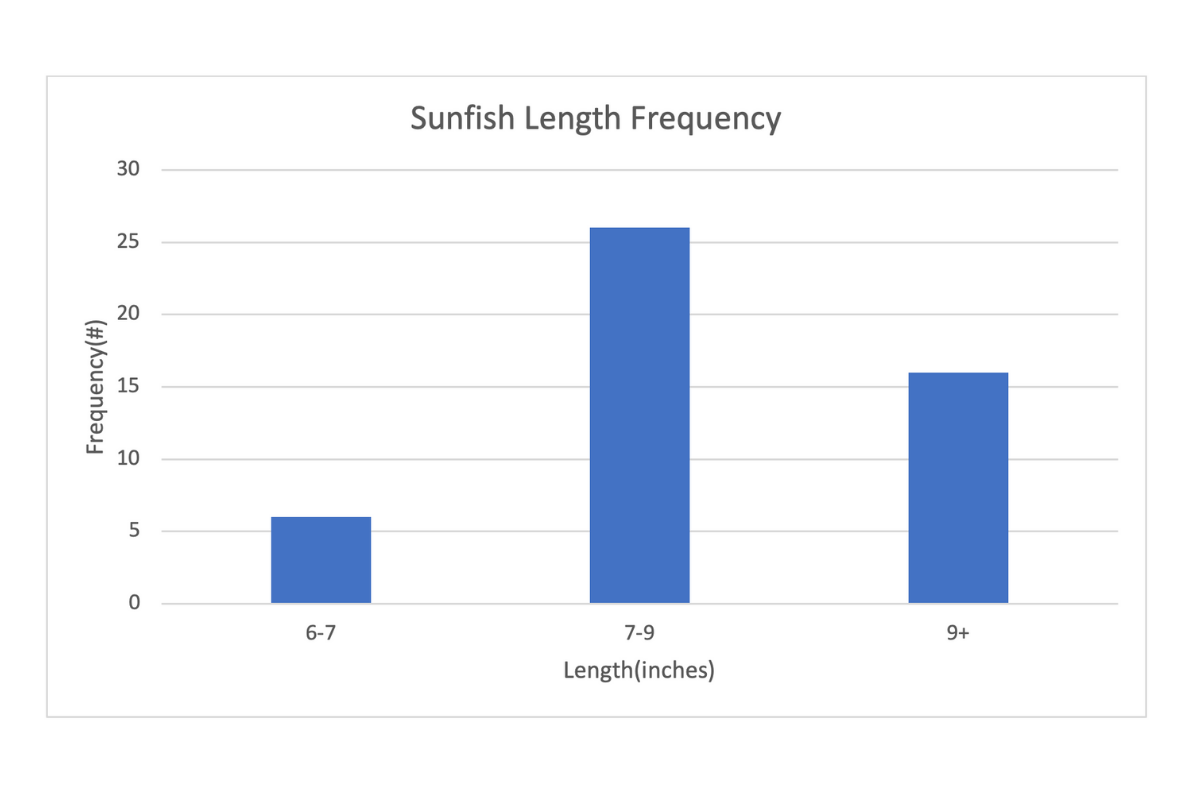In April 2021, TLC Perfect Pond conducted a comprehensive evaluation of a large community pond that is approximately 880 acres with about 700 acres of fishable area. We completed an electrofishing survey to analyze the overall fish population, we tested the physical and chemical properties of the water to determine water quality, and we identified any aquatic weeds and their coverage percentages.
The goal for this large pond was to create a well-balanced, freshwater sportfish population to provide members and their guests with quality fishing. The specific goals were to:
- Improve the trophy largemouth bass fishery
- Maintain quality panfishing (bluegill, redear sunfish, and black crappie)
- Maintain a high level of water quality and keep vegetation at acceptable levels
Water Quality Analysis
Our water testing yielded the following results:
- Alkalinity – 20ppm
- Hardness – 20 ppm
- pH – 6.5
- Dissolved oxygen – 10ppm
The dissolved oxygen numbers are within a normal range. The alkalinity and hardness numbers are concerning as they are at the lower limit of the threshold that we’d like to see in a freshwater fishery. The pH is also on the lower end of what we usually like to see in a healthy pond.
pH in ponds will naturally fluctuate during a 24 hour time frame as sunlight intensifies and dwindles. If the pond pH is on the low end of the acceptable range (which it is in this case), those swings can be deadly to the fish that live there. Improving the alkalinity of the pond will reduce the range of daily pH swing and increase the overall pH to protect the fish from toxic conditions.
Vegetation Analysis
Our evaluation of the existing pond vegetation revealed that the following species were present: water lillies, pickle weed, torpedo grass, broadleaf arrowhead, American frog bit, and watershield. Although the coverage of vegetation was not overwhelming, it is something that should be consistently monitored. We recommend no more than 10-20% vegetation coverage on a healthy pond or lake. If the vegetation starts to exceed that percentage, we should take action quickly to prevent rapid spread.
While some vegetation is good because it provides cover for prey species, too much vegetation provides excessive cover for prey species. This means the larger predators like largemouth bass have to work too hard to obtain prey. As a result, they spend as much energy catching prey as they get from eating the prey. The end result is a largemouth bass population that doesn’t produce trophy bass as it should in a healthy pond.
Fish Population Analysis
During our electrofishing survey, we observed the following species:
- Largemouth Bass
- Bluegill
- Redear Sunfish (shellcracker)
- Grass Carp
- Threadfin Shad
- Golden Shiner
- Bowfin
- Longnose Gar
We didn’t observe any crappie during the electrofishing survey, although they are often reported as being caught by the local fisherman. The lack of crappie in our sampling is likely a result of the time of year in which the sampling was performed.


Our Recommendations to Improve Trophy Largemouth Bass
Based on the data collected and the goals listed above for this community pond, our recommendations are listed below.
1) Introduce new genetics to the largemouth bass population. We believe that as large fish have been removed from the pond over the years, the genes that produced these large fish have been removed from the gene pool. We recommend implementing a plan to stock genetically superior strains of fish that are most likely to become trophy largemouth bass. These genetically superior fish will also breed with the existing bass to improve the gene pool. We can tag the stocked fish to ensure that they are released if caught.
2) Release trophy bass that are caught by fisherman. Although this may not be a popular strategy amongst the community pond fisherman, but it would greatly benefit the fishery. If a trophy largemouth bass is caught, it can be measured and weighed for a replica mount to be produced, then returned to the pond so it can continue to breed and add quality genetics to the population.
3) Harvest bass on a relative weight basis. While this can be tough to implement in a community pond, recent studies have shown that this is an extremely way to preserve quality genetics amongst a largemouth bass population. An example would be a 12″ bass that weighs 1 lb versus a 12″ bass that weighs 2 lbs. That 2 lb bass has the potential to be a trophy fish in the future while the 1 lb fish is average. The fish with the lower relative weights can be harvested while the fish with the higher relative weighs should be released so they can continue to grow.
4) Remove unwanted fish (bowfin and gar). These fish have no value to the community pond members and are competing with the largemouth bass for space and food. Removing these fish will provide more available breeding habitat and more prey for the largemouth bass population to grow faster.
5) Apply lime to the lake bottom. A liming application will improve the pH and adjust the alkalinity of the water so that drastic pH swings are not occurring during the warmer summer months. This will also promote more plankton growth, providing food for the species at the bottom of the food chain.
6) Monitor the population once a year to observe changes. A yearly survey will allow us to monitor the improvements occurring in this community pond and adjust our strategies so that we continue to improve the long-term fishing and abundance of trophy largemouth bass.

